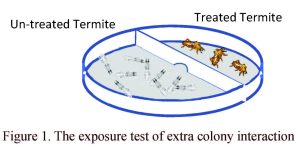〔Visiting Professor Report〕 Professor Sulaeman Yusuf Indonesian Institute of Science, Indonesia
Updated: 2022/09/28
The Study on Transmitting Behavior of Termite Treated by “Dusting Method” in Extra Colony Interaction
Professor Sulaeman Yusuf (Indonesian Institute of Science, Indonesia)
Dusting method for termite control was firstly introduced 40 y ears ago in Asia. However, the root of this method can be traced since 1915 in Australia by the use of arsenic powder as anti-termite agent. The success of dusting treatment depends on how much chemical powders stick to the surface of termite’s body and on the percentage area of termite’s body that are covered with chemicals. The ratio between the treated termites and untreated ones (control) will be affecting the outcome of colony elimination. Two important eusocial behaviours of termite colony members, i.e., “grooming” and “trophallaxis”, are expected to be the key procedures for the success of dusting treatment. Another termite behaviour called “cannibalisms”, which termites eat their dead colony mate, is also expected to contribute for the success of this approach. With those three distinct behaviours, the chemical powders from termite’s body will be spread throughout the colony.
ears ago in Asia. However, the root of this method can be traced since 1915 in Australia by the use of arsenic powder as anti-termite agent. The success of dusting treatment depends on how much chemical powders stick to the surface of termite’s body and on the percentage area of termite’s body that are covered with chemicals. The ratio between the treated termites and untreated ones (control) will be affecting the outcome of colony elimination. Two important eusocial behaviours of termite colony members, i.e., “grooming” and “trophallaxis”, are expected to be the key procedures for the success of dusting treatment. Another termite behaviour called “cannibalisms”, which termites eat their dead colony mate, is also expected to contribute for the success of this approach. With those three distinct behaviours, the chemical powders from termite’s body will be spread throughout the colony.
The application of dusting method usually uses treated termites from the same colony to release the chemical agent into a targeted colony (intra colony interaction). However, in this study we employed dusting treatment to be carried out on the workers of Coptotermes formosanus from a colony (Colony B1 at termite rearing laboratory – RISH) to be released in another colony (Colony B2). We would like to observe how effective the dusting treatment by experimenting extra colony interactions of the Formosan subterranean termite.
The application of Nile Blue A for marking C. formosanus
Nile Blue A was dissolved into distilled water to prepare dyeing solutions at concentration of 0.05%. Filter papers (55 mm in diameter, Whatman No. 2, Whatman BioSystem Ltd.) were dipped into one of the dyeing solutions for 10 seconds. Stained filter papers were air-dried overnight and served for forced-feeding by termite. Approximately 1000 termites (workers) were separated from a laboratory colony of C. formosanus and were put into a petri dish containing a moist-dyed filter paper. Undyed filter papers ware used as control. After three or five days, few of stained workers were randomly selected and transferred into another petri dish with two moist unstained filter paper. Five percent of soldiers were added to the stained workers group and daily observation was made to record the number of stained termites and survivors after few days.
The exposure set-up
We put 50 mg of fipronil into 4 cm of aluminium petri dish and shake it so that the fipronil spread evenly. Hundred workers of coloured termites (Colony B1) were put into a petri dish containing the fipronil and leave them for 5 minutes. After the exposure, the termites were removed and transferred into a filled petri dish termite control without staining from other colonies (Colony B2). Comparison between coloured termites that have been infected with fipronil and untreated termites (control) were 1:9, 2:8, 3:7, 4:6 and 5:5. Each treatment (Figure 1) were prepared in 3 replications. The mortality was calculated from each treatment and control.
Results
The experiment showed interesting results, as it had been thought that mixing two different termite colonies generate a fight and unrest behaviour between colonies, even if they were from one species. But in the current experiment, we found that two different colonies did not fight, instead they lived side by side. This phenomenon was unexpected outcome and inter-colonies termite behaviours need further studies to understand the dynamics and complexity. The question arises, is it possible that the two colonies from same species can live side by side, or event merging the colonies?
However, viewed from the mortality results, the data is as expected, the higher ratio of the treated termite the faster the mortality was (Figure 2). The results indicated that the fipronil chemical can spread or be transmitted through extra colony termite interactions (Figure 2).




